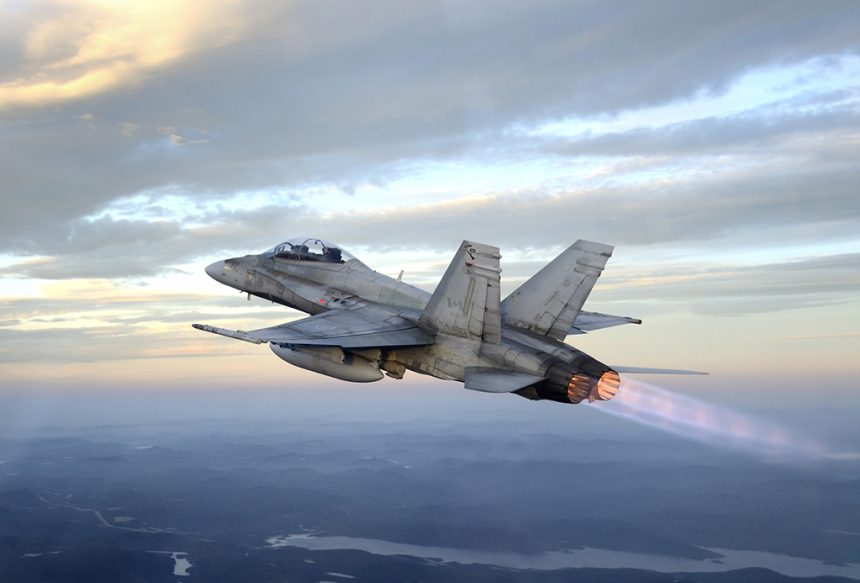Although they are two different airframes, the F-15 and the F-18 have similar avionics, as you can read in the following interesting story released by an experienced Eagle driver.
Disclaimer: the story is based on an interview to an F-15, published on a magazine profiling the F/A-18 Hornet.
Developed as a multirole naval fighter, the McDonnell Douglas (now Boeing) F/A-18 Hornet has become the backbone of the U.S. Navy, the U.S. Marine Corps and several air arms around the world.
Among them there is also the Royal Canadian Air Force (RCAF), formerly known as Canadian Forces Air Command, that began receiving a slightly modified version of the standard legacy Hornet, designated CF-18 (Canadian military designation is CF-188), in 1982.
Two years later, the first CF-18 fighter planes were also delivered to the Canadian units permanently based in Germany to replace their aging CF-104 Starfighter.
Some U.S. Air Force pilots stationed in Europe had a chance to learn more about the CF-18 capabilities. One of them was an F-15C pilot, Robert I “Scout” Winebrenner, who flew with Canadian Hornets while he was assigned to 32 Tactical Fighter Squadron in Soesterberg, the Netherlands.
In fact, during his tour of duty in Europe, Winebrenner became a Tactical Leadership Program (TLP) instructor and, as such, he had the opportunity to experience several observation flights aboard the two seat variants of the aircraft belonging to the units that took part to the exercise.
As Winebrenner recalls in Issue 23 “McDonnell Douglas F/A-18A/B/C/D Hornet” of Aviation Classics magazine, most of these flights were in the F-16s used by several European air forces, and in the Canadian CF-188B Hornets.
Dealing with the F-16, “Scout” explains that he never felt really comfortable in the Viper (as the Fighting Falcon is nicknamed by the fighter pilots community) cockpit even though the plane’s HOTAS (Hands On Throttle And Stick) feature provided the ability to perform myriad tasks without moving the hands away from the stick and throttles.
In particular, the radar scope located between the legs in the early “A” blocks felt like a “foreign object” in the first few flights on the F-16.
On the contrary his perspective from the CF-18 cockpit was completely different, as everything was where it was supposed to be.
The switches, knobs and gauges had a familiar look. Not surprising, since both the Eagle and the Hornet were McDonnel Douglas products and came from the same St. Louis plant.
Still, according to Scout, there were other reasons.
First of all, he felt extremely comfortable in the Hornet cockpit, to such an extent, after his very first flight on the plane, he said to the Canadian pilot who was flying in the front seat the following words: “You know, this could be completely over-the-top misplaced confidence on my part, but after that flight, I have the feeling that I could walk out there fire one up, and go out and fly the airplane, run the systems and even employ it tactically…just like that.”
During his several sorties on board Canadian Hornets, Winebrenner discovered that several functions of the CF-18 cockpit were even better than those owned by the Eagle one, such as the displays arrangement: whilst most Hornet fighter jocks put their radar display on the right MFD, the system was flexible and let the pilot chose the preferred arrangement.
He put his on the left (where the radar display is located in the F-15 cockpit), and “felt right at home.”
Moreover he liked the slightly larger HUD (Head Up Display), which gave to the cockpit a more modern appearance. The 70° gimbal limit was great. The stick grip was also well designed with the extra control knob (the ‘castle’ switch), and the same stick grip was fitted in the F-15C with the Multi-Staged Improvement Programme (MSIP) modification to run the Multi-Function Colour Display (MFCD) that worked also as Joint Tactical Information Distribution System (JTIDS) terminal.
But Winebrenner also found few things that he didn’t like about Hornet avionics, the first of those was the radar.
“Not that the Hughes APG-65 was a bad radar – far from it. But the narrower beam width and brute force of the F-15’s APG-63 was superior for most air-to-air situations. Moreover, the APG-65 was optimized for over-water operation, and incorporated some rather severe side-lobe suppression techniques which drastically reduced detection range if the Hornet was at lower altitude over land. The Eagle’s radar did similar things, but not anywhere near to the same extent.”
Thanks to its brute force and power, the APG-63 was better at dealing with Electronic Counter Measures (ECM) than the APG-65.
Another thing that Winebrenner liked more in the F-15C than in the CF-18, was the visibility in the cockpit, especially in the rear cockpit; however, in this case, we can’t but notice that the Eagle pilot was not impressed by the large single-piece bubble canopy with no forward bow frame that makes the Lockheed Martin F-16, at least the single seat, by far the fighter jet with the best 360° visibility of any combat plane in the world.
But, as a disclaimer, we told you at the beginning of this article that the interview was published on an issue dedicated to the F/A-18 Hornet….
Image credit: RCAF
















